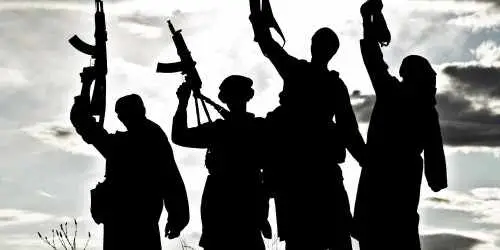Share on Social Media:
The Top 5 Deadliest Terrorist Groups in the World
| Terrorist Group (ideology) |
Deaths Caused | Injuries Caused | Terrorist Incidents | Attack Locations | |
|---|---|---|---|---|---|
| 1 | Boko Harem (Islamic fundamentalist) |
6,644 | 1,742 | 453 | Cameroon, Chad, Nigeria |
| 2 | ISIL/ ISIS (Islamic fundamentalist) |
6,073 | 5,799 | 1,071 | Egypt, Iraq, Lebanon, Syria, Turkey, France |
| 3 | Taliban (Islamic fundamentalist) |
3,477 | 3,310 | 891 | Afghanistan, Pakistan |
| 4 | Fulanii Militants (Islamic fundamentalist) |
1,229 | 395 | 154 | Central Africa Republic, Nigeria |
| 5 | Al Shabaab (al-Qa’ida affiliate) (Islamic fundamentalist) |
1,021 | 850 | 496 | Djibouti, Ethiopia, Kenya, Somalia |
 Special Report
Special Report
- Boko Harem also known as Jamā'at Ahl as-Sunnah lid-Da'wah wa'l-Jihād and more recently Islamic State's West Africa Province (ISWAP) seeks to establish an Islamic state in Nigeria, a country which is divided between the Christian south and the Muslim north. In 2014 Boko Haram doubled its attacks and more than quadrupled the number of deaths from terrorism. Boko Haram also has logistic routes running through the border regions of Cameroon and Chad. Private citizens, who make up 77 per cent of fatalities, are overwhelmingly the target of Boko Haram's attacks. These attacks are also extremely deadly, with an average of 17 people killed per attack. Boko Haram has increased the use and lethality of bombings and explosions, largely due to the increased training from other terrorist groups. The name Boko Haram can be translated as "Western education is forbidden." (a).
- ISIL, also known as ISIS, Islamic State or Daesh, is a terrorist group based in Syria and Iraq. It emerged from al-Qa'ida in Iraq, moving into Syria during the Syrian civil war. Like other fundamentalist jihadi groups, ISIL seeks to create an area of Islamic rule. As of 2015, They control a significant amount of territory in both Iraq and Syria. ISIL aspires to control the Levant region which includes Israel, Iraq, Jordan, Lebanon and Syria. The entire organisation is led by Abu Bakr al-Baghdadi who is known as the Caliph or political successor. ISIL has a strong military presence in the region with many former members of the Iraqi army under the Saddam Hussein regime. Ninety per cent of attacks were in Iraq with the cities of Nineveh, Al Anbar, Baghdad and Saladin accounting for 73 per cent of total deaths. Other attacks occurred in Syria resulting in 615 deaths from 89 attacks, Egypt recorded 10 deaths from three attacks, Lebanon had 51 deaths from 18 attacks, Turkey recorded 128 deaths from 4 attacks and most recently attacks in Paris have resulted in 130 deaths. The majority of attacks targeted civilians, who account for 44 per cent of deaths. Over half of attacks on civilians were kidnappings or assassinations. The biggest attacks by ISIL were massacres and kidnappings of private citizens. (a).
- In 2014 the Taliban killed the most people from terrorism since the invasion of Afghanistan in 2002. There were 3,477 people killed from 891 attacks, which is a 38 per cent increase in fatalities and 48 per cent increase in attacks from the previous year. The Taliban are seeking to destabilise the country through undermining the institutions of government. For this reason the police were the major target of the Taliban, accounting for 45 per cent of incidents and 53 per cent of deaths. On average there are 4.6 deaths per incident from attacks targeting the police. The second biggest targetn was private civilians who were targets for around 20 per cent of both incidents and deaths, with an average of 4.3 deaths per attack. (a).
- Fulani militants in Nigeria come from a semi-nomadic, pastoralist ethnic group and are engaged in conflict with farming communities. There was a dramatic increase in attacks by Fulani militants in 2014. From 2010 to 2013, Fulani militants killed around 80 people in total. In 2014, Fulani militants killed 1,229. Overwhelmingly, Fulani militants target private citizens accounting for 92 per cent of attacks and 81 per cent of deaths. These attacks have mainly been through armed assaults, which kill, on average, 11 people per attack. The largest attack committed by Fulani militants was in April 2014 when assailants opened fire on community leaders and residents that were meeting in Galadima village in Zamfara state, killing at least 200 people. (a).
- Al-Shabaab, also known as Harakat al-Shabab al- Mujahideen, is an al-Qa'ida affiliate based in Somalia that is seeking to create an Islamic state in Somalia. 2014 was the deadliest year for the group with the number of deaths from terrorism doubling to 1,021 and the number of attacks increasing by one and a half times to nearly 500. Private citizens are the target of 36 per cent of attacks, with an average of 2.5 deaths per attack. The military is also a major target of al-Shabaab, accounting for 237 deaths over 55 attacks. (a).
a. Institute for Economics and Peace (2015): "Global Terrorism Index 2015"
Tags:
Death Statistics, Deadliest, Africa, The Middle East
Sources: Institute for Economics and Peace: "Global Terrorism Index 2015"
List Notes: Data is the Top 5 Deadliest Terrorist Groups for the year 2014 ranked by the number of deaths caused by terrorist attacks perpetrated by these groups.
Sources: Institute for Economics and Peace: "Global Terrorism Index 2015"
List Notes: Data is the Top 5 Deadliest Terrorist Groups for the year 2014 ranked by the number of deaths caused by terrorist attacks perpetrated by these groups.

